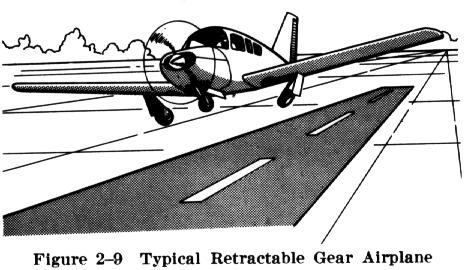
Many airplanes are equipped with a retractable landing gear to reduce
the drag created while it is extended during flight. Some landing gears
retract rearward into the wing and some sideways into the wing (Fig. 2-9).
Others retract into the fuselage, and some into the engine nacelles. The
retraction and extension device may be operated either manually, hydraulically,
or electrically. Warning indicators are provided to show the pilot when
the wheels are down and when they are up, or if they are stuck part way.
In nearly all installations, systems for emergency operation are provided.
| Devices used in a typical hydraulically operated landing gear retraction system include actuating cylinders, position selector valves, uplocks, downlocks, sequence valves, tubing, and other conventional hydraulic components. These units are so interconnected that they permit properly sequenced retraction and extension of the landing gear and the landing gear doors or fairing. When the landing gear control in the cockpit is moved to the UP or DOWN position, the landing gear retracts or extends as selected, by the force of hydraulic pressure which is applied to the up or down side of the gear actuator. The gear actuator applies the force required to raise and lower the gear as selected. A locking mechanism locks the gear in the desired up or down position, so that the gear will remain in that position until the pilot operates the landing gear control. |  |
Basically, the electrically operated system is an electrically driven screwjack for raising or lowering the landing gear. When the landing gear switch in the cockpit is moved to the UP position, the electric motor operates. Through a system of shafts, gears, adapters, an actuator screw, and torque tube, a force is transmitted to the landing gear strut. Thus, the landing gear retracts and locks. If the switch is moved to the DOWN position, the motor reverses and the gear is moved down and locks. The sequential operation of fairing doors and landing gear is similar to that of the hydraulically operated landing gear system.
An emergency extension system installed in the airplane permits the pilot to lower the landing gear if the main electrical or hydraulic power system fails. The design configurations of some airplanes make emergency extension of the landing gear by gravity and airloads alone impossible or impractical. In such airplanes, provisions are included for forceful gear extension in an emergency. Some installations are designed so that either hydraulic fluid or compressed air provides the necessary pressure, while others use a manual system for extending the landing gear under emergency conditions.